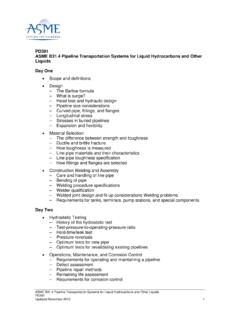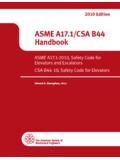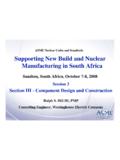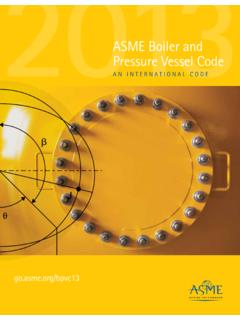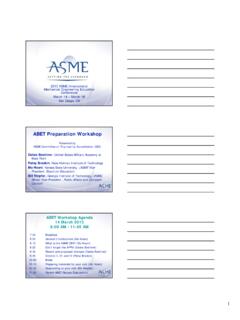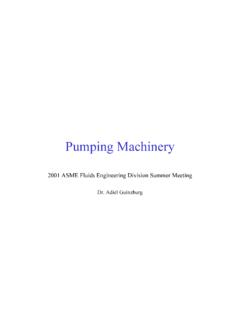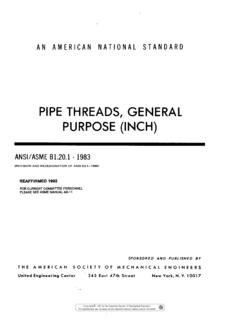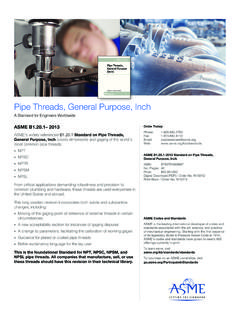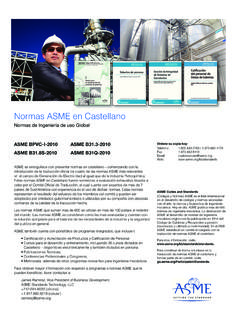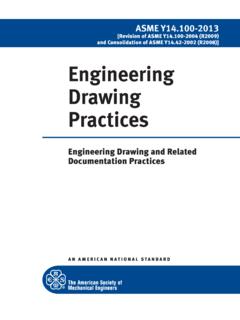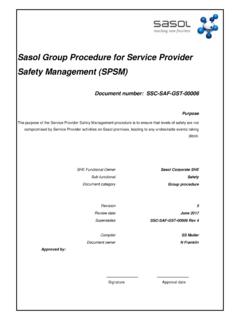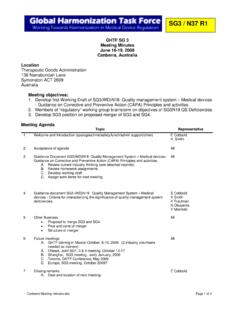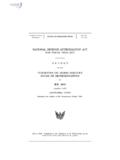Transcription of Session 3: ASME Section III,
1 Session 3: asme Section III, Component Design and Construction, IncludingApplication to the AREVA EPRP hilippe MALOUINESR egulations and Codes AdvisorASME InspectorAREVA NP-EIRA asme NUCLEAR CODES AND STANDARDS Supporting New Build and Nuclear Manufacturing in South AfricaASME Code for implementation in EPR asme Semina in RSA r October 7th, 200833 EPR CODES AND STANDARDS : ContentXAREVA welcomes you in Session situation: which Code for EPR components ? X2. Principles of Code selectionX3. Origin of RCC-M rules and recent evolutionsX4. asme vs RCC-M : puzzles and overlappingsX5. ConclusionsASME Code for implementation in EPR asme Semina in RSA r October 7th, 2008441. Which code for AREVA EPR for NI, safety class 1 main component?EPR Olkiluoto 3 FinlandRCC-M 2005 Started, in progressFinnishregulation refersto asme or otherequivalent CodeEPR Flamanville 3 RCC-M 2007 Started, in progressFrench regulationdoes not makemandatory anyCodeEPR TaishanRCC-M 2007 StartedChineseregulation doesnot makemandatory anyCodeEPR USAASME IIIPre-licencingphaseUS regulationmakes asme consistent withany licenceASME Code for implementation in EPR asme Semina in RSA r October 7th, 2008551.
2 Which code for AREVA EPR: NI (SC2 & SC3 & NC), BOP, CI ? EPR Olkiluoto 3 FinlandRCC-M 2005, asme Sect. III , Sect. VIII, KTA,EN 13445, EN 13480,..YVL:Finnish regulation, includes CE assessmentfor nuclear Not Classified(NC) Flamanville 3 RCC-M 2007, asme Sect. III and Sect. VIII,KTA,EN 13445, EN 13480,..French regulation includesCE assessment for nuclearNot Classified (NC) equipmentEPR TaishanRCC-M 2007 level 2 and 3, asme Sect. III and Sect. VIII,EN 13445, EN 13480, ChinesestandardsChinese regulation doesnot make mandatory anyCodeEPR USAASME Sect. III, Sect. VIII,US regulation makes asme consistent with any licenceNI:Nuclear Island CI:Conventional IslandBOP:Balance of Plant CE: Stamp witnessing the conformity to European RegulationsASME Code for implementation in EPR asme Semina in RSA r October 7th, 2008662.
3 Principles for Code selectionXPrinciples applied as a function of safety classification: safety Report of the Owner is the baseXNeeds High level of safety High availability factor during 60 years Reasonable equipment and maintenance costs Low radiation exposure of workers Standardization to benefit from experienceXIndustrial context Equipment requirements from Contractor Engineering departments Consideration of Suppliers experience: market opening EvolutionaryPressurized Water Reactorfirst developed in a French-German context. Today ready for US and deploymentanywhere in the Code for implementation in EPR asme Semina in RSA r October 7th, for specifying EquipmentXGlobal safety Approach Carefulselection of Materials Optimized System and Equipment design Low probability of Defect CarefulNon-Destructive Examinations Implementation of QA System (Regulation RD 0034 in RSA) When needed (regulations), measures allowing a "break preclusion concept" to be used When needed (regulations), severe accidental conditions to beconsidered (Finland).
4 XClassification of Equipment As a function of safety class (SC1, SC2, SC3) As a function of Nuclear Pressure Equipment Regulations( N1, N2, N3 in the context of the French Regulation)As a result, equipment are classified in "Quality Classes" Q1, Q2, Q3 asme Code for implementation in EPR asme Semina in RSA r October 7th, 2008882. General strategy for EPR Codes and Standards selection: Nuclear Island,Balance of Plant,Conventional +Sect. IIINC or RCC-MSubs. CKTA+3211 ClassificationQ1Q2Q3 NCASME Sect. III ND+Harmonized StandardsPED 97/23 ECEPRG lobal ApplicationASME +or National Industrial Standards+: supplementedwhenneededPlus specificrequirementsNuclearcodes optionalRCC-MSect. ISubs. BEPR asme asme Sect. VIII Standards: EN 13445, 13480,..National Industrial Standards: asme VIII, AD-M, CODAP.
5 Or asme +Sect. IIINC or asme Sect. VIII Code for implementation in EPR asme Semina in RSA r October 7th, 2008992. Consequences on Q2/Q3,NC Equipment SpecificationsXNecessity to adapt equipment specifications with Provisions in addition to the codeXPhilosophy Supplement with adequate provisions the applicable codes and/or standards Reach an equivalent global quality levelXCompatibility conditions whenever several codes are usedzCompatibility on dimensionszCompatibility with hypotheses on general system designzConsideration of fatigue riskszSpecification of applicable criteria levelszConsideration of inspection liable to affect designzConsistency of materials and range of approval of qualificationszPressure tests, Code for implementation in EPR asme Semina in RSA r October 7th, 200810102.
6 Established conclusions for Nuclear Codes approachNot only from AREVA point of Code for implementation in EPR asme Semina in RSA r October 7th, Aspects : origin of RCC rulesUS regulations, codes and standards for the general design of systems and componentsPWR technology progressively adapted to French and European industrial and regulatory contextFrench and European rules, regulations and practices for the construction of componentsFirst RCC-M was picture of practices in 80 sPragmatic approach: more than 60 NPP designed, manufactured, with rules set up in RCCASME Code for implementation in EPR asme Semina in RSA r October 7th, 20081212 Section 1 Nuclear IslandSection IIIC omponentsAGeneral requirementsNCABC lass 1 componentsNBCC lass 2 componentsNCDC lass 3 componentsNDE Small componentsNoneGCore support structuresNGHS upportsNFJS torage tanksNC/ND 3800-3900 PContainment penetrationsNEZT echnical appendicesAppendicesSection 2 MaterialsSection IISection 3 Examination methodsSection VSection 4 WeldingSection IX (Qualifications) Section 5 FabricationVarious parts of Sect.
7 III3. RCC-M vs asme general organizationRCC-M CodeASME CodeASME Code for implementation in EPR asme Semina in RSA r October 7th, 200813133. How are established RCC requirements: in AfcenBOARDG eneral SecretaryEditorial committeeRCC-C SubcommitteeRCC-E SubcommitteeRCC-M SubcommitteeRCC-MR SubcommitteeRSE-M SubcommitteeWorking GroupDesignMaterialsTechnologyGeneral QualificationDesign GeneralDesignMaterialsInspectionNDEFlaw AnalysisExaminationSoftwareInstallations ExaminationFabricationRepairEDF, AREVA,CEA, DCN, Nuclearapproved Inspection Bodies involved in RCC-M assessmentthrough regulationsASME Code for implementation in EPR asme Semina in RSA r October 7th, 200814143. Main points of RCC-M approach and evolutions XRCC codes are Tools Integrating construction and operation experience Open to different regulatory contextsXRCC-M is continuously evolving as a function of Contractor and Supplier experience and research, Projects needs Evolution of International standards: calculations.
8 Regulatory evolutions XRCC-M 2007 edition integrates EPR project needs Standards updating Regulatory evolutions resulting from European PED and French ESPN Order: example for materials requirementsXIntegration of appendices covering other regulatory contexts under consideration: exampleNo drastic changesContinuous adaptationsASME Code for implementation in EPR asme Semina in RSA r October 7th, 200815154. RCC-M technical diffences vs asme III XDesign Mechanical resistance Functional requirements out of scopeXMaterials Materials selection Procurement Part qualificationXManufacturing Fabrication and welding Process and welders QualificationsXExaminations Stage Methods Extent Acceptance criteriaXHydrostatic testsXOverpressure protection Issued in 20072,4,7,83,5,619,13111214* : source: MDEP asme presentation10,Technicaldifferences* asme Code for implementation in EPR asme Semina in RSA r October 7th, 200816164.
9 RCC-M technical scope vs asme III:Technical differences1 Material: asme uses generic prequalification/ RCC-M uses prototype qualification (M140)2 Material Stress Limits: asme Section III, Class 2 and 3 allowable stresses are now up to 15% higher than those of the RCC-M Code, because Section III stress limits are now based on a design factor of rather than 43 Material: RCC-M permits use of only very low carbon stainless steels with nitrogen limits. Determination of sensitivity to IGSCC, by corrosion testing, is required if the carbon content exceeds specified limits ( ). asme Section III leaves material selection and IGSCC concerns to the Owner or Material: RCC-M requires elevated-temperature tensile testing (base metal, weld metal, procedure qualifications) to confirm the elevated-temperature tensile and yield strengths for each heat/lot and welding procedure/ asme relies on properties from representative heats to establish allowable stresses at elevated temperatures.
10 Design factors compensate for unknowns and variations5 Material: RCC-M requires impact testing with little regard for material composition or experience. It requires impact testing of materials that are exempted from testing by asme Section III because of their inherent high toughness, such as austenitic stainless steel filler metal. These tests are not required by asme Section Material: RCC-M imposes a delta ferrite limit of 5-15%. The Section III limit is 5FN minimum. Section III does not have a maximum limit. High delta ferrite has not resulted in RCC-M requires corrosion testing if the carbon content exceeds asme Section III does not require corrosion Design: Reinforced Openings, Class 1 Vessels - Same design approach, but RCC-M requires full stress analysis of openings, in addition to reinforcement asme Class 1 Piping - Same design approach, but RCC-M requires full stress Design: Fatigue at Discontinuities - Same basic approach in both Codes, but RCC-M has add new detailled conditions of use of fatigue Welding qualification: RCC-M requires production weld test coupons.
